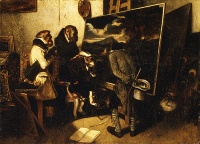Art criticism
From The Art and Popular Culture Encyclopedia

|
Related e |
|
Featured: |
- "What is the good of criticism? What is the good? -- A vast and terrible question mark which seizes the critic by the throat from the very first step in the first chapter he sets down to write," asks French writer Baudelaire in 1846.
- Subjects: death of the avant-garde, art theory, aesthetics
- People: Donald Kuspit, Manny Farber, Susan Sontag, Clement Greenberg, Arthur C. Danto, John Ruskin, Paul Taylor, Catherine Millet, Harold Rosenberg, John Berger, Rosalind E. Krauss, Mario Praz, Yve-Alain Bois, Denis Hollier, Hal Foster, Heinrich Wölfflin, T. J. Clark
Art criticism is the written discussion or evaluation of visual art.
Art critics usually criticize art in the context of aesthetics or the theory of beauty. One of criticism's goals is the pursuit of a rational basis for art appreciation.
Though critiques of art may have lasted as long as art itself, art criticism as a genre refers to a systematic study of art performed by scholars and dedicated students of art and art theory. Throughout history, wealthy patrons have employed art-evaluators; however, only from the 19th century onwards has criticism had developed formal methods and became a more common vocation.
The variety of artistic movements has resulted in a division of art criticism into different disciplines, each using vastly different criteria for their judgements. The most common division in the field of criticism is between historical criticism and evaluation, a form of art history, and contemporary criticism of work by living artists. Despite perceptions that art criticism is a much lower risk activity than making art, opinions of current art are always liable to drastic corrections with the passage of time. Critics of the past are often ridiculed for either favoring artists now derided (like the academic painters of the late 19th Century) or dismissing artists now venerated (like the early work of the Impressionists). Some art movements themselves were named disparagingly by critics, with the name later adopted as a sort of badge of honor by the artists of the style (e.g. Impressionism, Cubism), the original negative meaning forgotten.
Artists have often had an uneasy relationship with their critics. Artists usually needs positive opinions from critics for their work to be viewed and purchased; unfortunately for the artists, only later generations may understand it. Some critics are unable to adapt to new movements in art and allow their opinions to override their objectivity, resulting in inappropriately dated critique. John Ruskin famously compared one of James Whistler's paintings to "flinging a pot of paint in the public's face".
History
Although critiques of art may have its origins in the origins of art itself, art criticism as a genre is credited to have acquired its modern form by the 18th century.
The first writer to acquire an individual reputation as an art critic in 18th C. France was La Font de Saint-Yenne who wrote about the Salon of 1737 and wrote primarily to entertain while including anti-monarchist rhetoric in his prose.
The 18th C. French writer Denis Diderot is usually credited with the invention of the modern medium of art criticism. Diderot's "The Salon of 1765" was one of the first real attempts to capture art in words. According to art historian Thomas E. Crow, "When Diderot took up art criticism it was on the heels of the first generation of professional writers who made it their business to offer descriptions and judgments of contemporary painting and sculpture. The demand for such commentary was a product of the similarly novel institution of regular, free, public exhibitions of the latest art." [Published in Diderot on Art I, p.x]
Later professional Salon de Paris critics include such as Gustave Planche, Theophile Gautier, Theophile Thore, Jules Champfleury and Charles Baudelaire.
See also
- What Is Art?
- Art theory
- Literary criticism
- Baudelaire's art and literary criticism
- French art criticism


